Parliament House (India)
The Sansad Bhavan (English: Parliament House) is the house of the Parliament of India, which contains the Lok Sabha and the Rajya Sabha located in New Delhi.
| Sansad Bhavan Parliament House | |
|---|---|
 Parliament House, seen from Rajpath | |
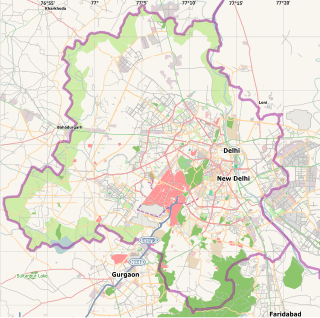 | |
| Former names | House of Parliament |
| Alternative names | Parliament Building |
| General information | |
| Status | Functioning |
| Architectural style | Lutyens' Delhi |
| Address | Sansad Marg, New Delhi, India |
| Town or city | New Delhi |
| Country | |
| Coordinates | 28.617189°N 77.208084°E |
| Construction started | 1921 |
| Opened | 1927 |
| Owner | British India (1927-1947) Government of India (1950-present) |
| Design and construction | |
| Architect | Edwin Lutyens and Herbert Baker |
| Other information | |
| Seating capacity | 790 |
History
.png)
Originally called the House of Parliament, it was designed by the British architects Sir Edwin Lutyens and Sir Herbert Baker in 1912-1913 as part of their wider mandate to construct a new administrative capital city for British India. It is said that the circular structure of the 11th-century Chausath Yogini Temple may also have inspired the design of the building.[1] Construction of the Parliament House began in 1921 and it was completed in 1927.
The opening ceremony of the Parliament House, which then housed the Imperial Legislative Council, was performed on 18 January 1927 by Lord Irwin, Viceroy of India. The third session of Central Legislative Assembly was held in this house on 19 January 1927.[2]
Two floors were added to the structure in 1956 due to a demand for more space.[3]
The Parliament Museum, opened in 2006, stands next to the Parliament House in the building of the Parliamentary Library.
Building
The shape of the building is circular, which is based on the Chausath Yogini temple. At the centre of the building is the Central Chamber, and surrounding this are the semicircular halls that were constructed for the sessions of the Chamber of Princes (now used as the Library Hall), the State Council (now used for the Rajya Sabha), and the Central Legislative Assembly (now used for the Lok Sabha). The building is surrounded by large gardens and the perimeter is fenced off by sandstone railings (jali).[4]
Proposal for a new building
A new Parliament building may replace the existing complex. The new building is being considered on account of the stability concerns regarding the current complex.[5] A committee to suggest several alternatives to the current building has been set up by the ex-Speaker, Meira Kumar. The present building, an 85-year-old structure suffers from inadequacy of space to house members and their staff and is thought to suffer from structural issues. The building also needs to be protected because of its heritage.[6] On August 5, 2019, the Vice president and chairperson of the upper house of Indian parliament (Rajyasabha) Venkaiah Naidu proposed to Prime Minister Narendra Modi to have a new building for the Parliament. In January 2020, Lok Sabha speaker Om Birla announced that parliament will be holding its sessions in a new building in 2022 when country would celebrating its 75th independence day. Renovation of central vista from Rashtrapati Bhavan to India Gate is also underway.[7]
Lok Sabha chamber is expected to have increased seating capacity to accommodate more members as number of MPs may increase with India's population. Lok Sabha may need to have 848 members by 2026. New complex will able to house 900 Lok Sabha MPs and 1350 members in total. According to Bimal Patel, the architect in charge of the redesign of Central Vista, the new complex is likely to have a triangular shape. It will be built next to the existing complex and will be much bigger than former one. North and south blocks which house ministries will be converted into museums and relocation PMO and ministries and redesign of Rajpath will take place.[8][9][10]
2001 Parliament attack
On 13 December 2001, the building of the Parliament was attacked by five Lashkar-e-Toiba and Jaish-e-Mohammed terrorists. In addition to all the attackers, six military personnel and one civilian were killed.[11]
Gallery
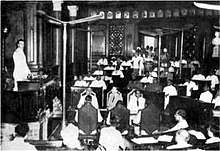 Lord Mountbatten addressing the Chamber of Princes as Viceroy in 1947.
Lord Mountbatten addressing the Chamber of Princes as Viceroy in 1947.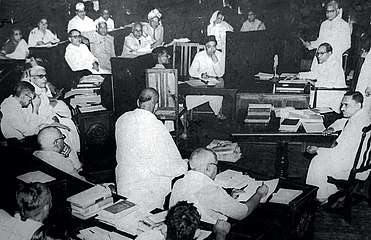 A Constituent Assembly of India meeting in 1950.
A Constituent Assembly of India meeting in 1950.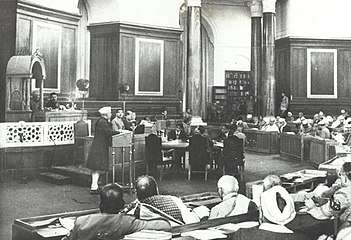 Jawaharlal Nehru addressing the constituent assembly in 1946.
Jawaharlal Nehru addressing the constituent assembly in 1946.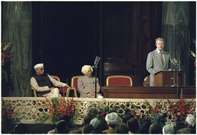 Indian Prime Minister Morarji Desai listens to U.S President Jimmy Carter as he addresses the Indian Parliament House in 1978.
Indian Prime Minister Morarji Desai listens to U.S President Jimmy Carter as he addresses the Indian Parliament House in 1978.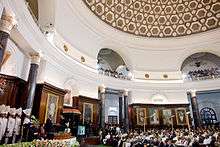 U.S President Barack Obama addressing Joint Session of the Parliament in 2010.
U.S President Barack Obama addressing Joint Session of the Parliament in 2010.
See also
References
- "Temples which inspired design of Indian Parliament: Madhya Pradesh's Chausath Yogini Mandir". The Financial Express. 11 May 2019. Retrieved 7 July 2019.
- "History of the Parliament of Delhi". delhiassembly.nic.in. Retrieved 13 December 2013.
- https://indianexpress.com/article/india/central-vista-project-new-delhi-dr-bimal-patel-parliament-prime-minister-office-rajpath-6212011/
- "Parliament House: 144 pillars of pride". Hindustan Times. 7 June 2011. Retrieved 20 August 2018.
- "Delhi may see a new Parliament building". timesofindia.indiatimes.com. 13 July 2012. Retrieved 13 December 2013.
- Firstpost (13 July 2012). "Speaker sets up panel to suggest new home for Parliament". Firstpost. Retrieved 15 August 2012.
- "Parliament session will be held in new building in 2022: Lok Sabha Speaker". The Times of India. 8 January 2020. Retrieved 1 February 2020.
- Nidhi Sharma (16 January 2020). "New parliament plan: Twin-sharing seat, many aisles". Retrieved 1 February 2020.
- Arnab Dutta (16 January 2020). "New PM house, PMO & Parliament before 2024; ministries along central vista". Retrieved 1 February 2020.
- Anisha Dutta (31 January 2020). "New Parliament complex may seat 1,350 members". Retrieved 1 February 2020.
- "Terrorists attack Parliament; five intruders, six cops killed". rediff.com. 13 December 2001. Retrieved 13 December 2013.
External links

- The Parliament Estate, Parliament of India webpage[1]
- Lessons, My Online. "Parliament of India | Indian Polity". myonlinelessons.in. Archived from the original on 2 April 2019. Retrieved 2 April 2019.